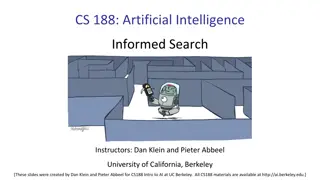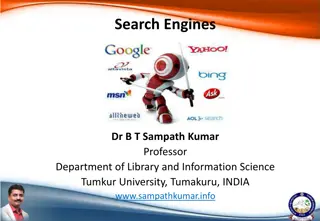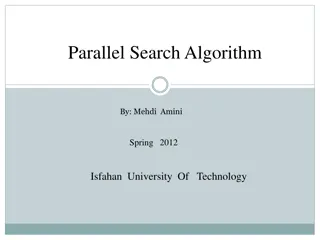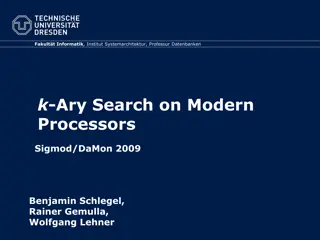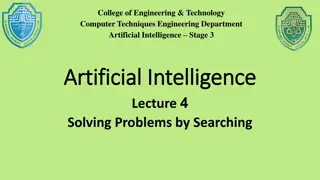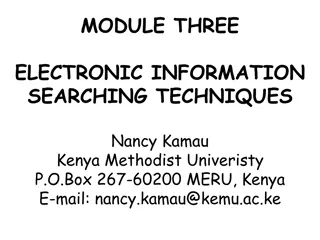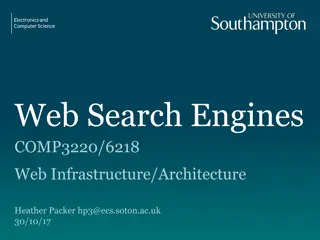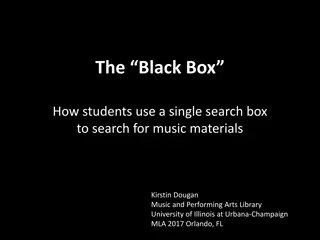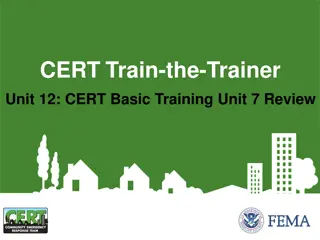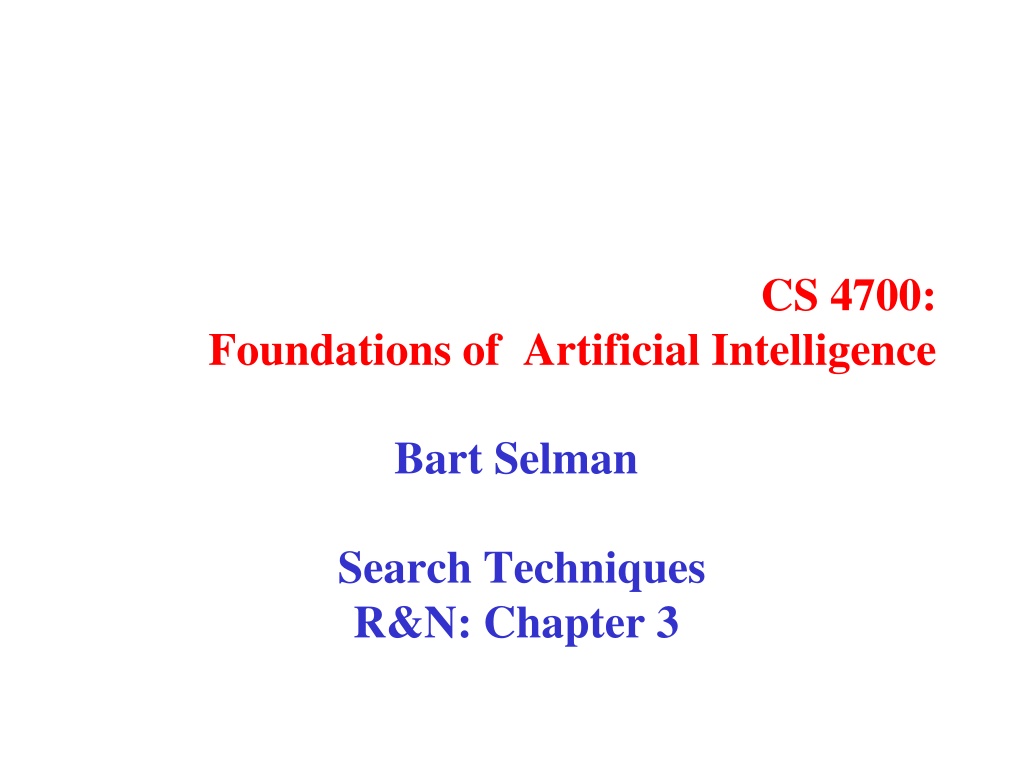
Artificial Intelligence Search Techniques Overview
Explore various search techniques in artificial intelligence including uninformed and informed strategies, tree search algorithms, node expansion, and graph search. Understand the basic principles involved in searching through state spaces to find optimal solutions.
Download Presentation

Please find below an Image/Link to download the presentation.
The content on the website is provided AS IS for your information and personal use only. It may not be sold, licensed, or shared on other websites without obtaining consent from the author. If you encounter any issues during the download, it is possible that the publisher has removed the file from their server.
You are allowed to download the files provided on this website for personal or commercial use, subject to the condition that they are used lawfully. All files are the property of their respective owners.
The content on the website is provided AS IS for your information and personal use only. It may not be sold, licensed, or shared on other websites without obtaining consent from the author.
E N D
Presentation Transcript
CS 4700: Foundations of Artificial Intelligence Bart Selman Search Techniques R&N: Chapter 3
Outline Search: tree search and graph search Uninformed search: very briefly (covered before in other pre- requisite courses recommendation: review these techniques at home) Informed search focus of the lecture
Uninformed search strategies Uninformed (blind) search strategies use only the information available in the problem definition: Breadth-first search Uniform-cost search Depth-first search Depth-limited search Iterative deepening search Bidirectional search Key issue: type of queue used for the fringe of the search tree (collection of tree nodes that have been generated but not yet expanded)
Tree-search algorithms Searching for a (shortest / least cost) path to goal state(s). Search through the state space. We will consider search techniques that use an explicit search tree that is generated by the initial state + successor function. initialize (initial node) Loop choose a node for expansion according to a strategy goal node? expand node with successor function done
Tree search example Node selected for expansion.
Selected for expansion. Added to tree. Note: Arad added (again) to tree! (reachable from Sibiu) Not necessarily a problem, but in Graph-Search, we will avoid this by maintaining an explored list.
Tree-search algorithms Basic idea: simulated exploration of state space by generating successors of already-explored states (a.k.a. ~ expanding states) Fig. 3.7 R&N, p. 77 Note: 1) Here we only check a node for possibly being a goal state, after we select the node for expansion. 2) A node is a data structure containing state + additional info (parent node, etc.
Graph-search Fig. 3.7 R&N, p. 77. See also exercise 3.13. Note: 1) Uses explored set to avoid visiting already explored states. 2) Uses frontier set to store states that remain to be explored and expanded. 3) However, with eg uniform cost search, we need to make a special check when node (i.e. state) is on frontier. Details later.
Search strategies A search strategy is defined by picking the order of node expansion. Strategies are evaluated along the following dimensions: completeness: does it always find a solution if one exists? time complexity: number of nodes generated space complexity: maximum number of nodes in memory optimality: does it always find a least-cost solution? Time and space complexity are measured in terms of b: maximum branching factor of the search tree d: depth of the least-cost solution m: maximum depth of the state space (may be )
Uninformed search strategies Uninformed (blind) search strategies use only the information available in the problem definition: Breadth-first search Uniform-cost search Depth-first search Depth-limited search Iterative deepening search Bidirectional search Key issue: type of queue used for the fringe of the search tree (collection of tree nodes that have been generated but not yet expanded)
Breadth-first search Expand shallowest unexpanded node. Implementation: fringe is a FIFO queue, i.e., new nodes go at end (First In First Out queue.) Fringe queue: <A> Select A from queue and expand. Gives <B, C>
Queue: <B, C> Select B from front, and expand. Put children at the end. Gives <C, D, E>
Fringe queue: <D, E, F, G> Assuming no further children, queue becomes <E, F, G>, <F, G>, <G>, <>. Each time node checked for goal state.
Properties of breadth-first search (check them at home!!!!) Note: check for goal only when node is expanded. Complete? Yes (if b is finite) Time? 1+b+b2+b3+ +bd + b(bd-1) = O(bd+1) Depth d, goal may be last node (only checked when expanded.). Space? O(bd+1)(keeps every node in memory; needed also to reconstruct soln. path) Optimal soln. found? Yes (if all step costs are identical) Space is the bigger problem (more than time) b: maximum branching factor of the search tree d: depth of the least-cost solution
Uniform Cost We factor in the cost of each step (e.g., distance form current state to the neighbors). Assumption: costs are non-negative. g(n) = cost so far to reach n Queue ordered by cost If all the steps are the same breadth-first search is optimal since it always expands the shallowest (least cost)! Uniform-cost search expand first the nodes with lowest cost (instead of depth). Does it ring a bell?
Uniform-cost search Two subtleties: (bottom p. 83 Norvig) 1) Do goal state test, only when a node is selected for expansion. (Reason: Bucharest may occur on frontier with a longer than optimal path. It won t be selected for expansion yet. Other nodes will be expanded first, leading us to uncover a shorter path to Bucharest. See also point 2). 2) Graph-search alg. says don t add child node to frontier if already on explored list or already on frontier. BUT, child may give a shorter path to a state already on frontier. Then, we need to modify the existing node on frontier with the shorter path. See fig. 3.14 (else-if part).
Uniform-cost search Expand least-cost (of path to) unexpanded node (e.g. useful for finding shortest path on map) Implementation: fringe = queue ordered by path cost g cost of reaching a node Complete? Yes, if step cost (>0) Time? # of nodes with g cost of optimal solution (C*), O(b(1+ C*/ ) Space? # of nodes with g cost of optimal solution, O(b(1+ C*/ ) Optimal? Yes nodes expanded in increasing order of g(n) Note: Some subtleties (e.g. checking for goal state). See p 84 R&N. Also, next slide. Note: search is guided by cost not depth!!! Note: search is guided by cost not depth!!!
Depth-first search Expand deepest unexpanded node Implementation: fringe = LIFO queue, i.e., put successors at front ( push on stack ) Last In First Out Fringe stack: A Expanding A, gives stack: B C So, B next.
Expanding B, gives stack: D E C So, D next.
Expanding D, gives stack: H I E C So, H next. etc.
Properties of depth-first search No: fails in infinite-depth spaces, spaces with loops Modify to avoid repeated states along path complete in finite spaces Complete? Time? O(bm): bad if m is much larger than d but if solutions are dense, may be much faster than breadth-first Note: Can also reconstruct soln. path from single stored branch. O(bm), i.e., linear space! Space? b: max. branching factor of the search tree d: depth of the shallowest (least-cost) soln. m: maximum depth of state space Guarantee that opt. soln. is found? No Note: In backtrack search only one successor is generated only O(m) memory is needed; also successor is modification of the current state, but we have to be able to undo each modification. More when we talk about Constraint Satisfaction Problems (CSP).
Why would one do that? Combine good memory requirements of depth-first with the completeness of breadth-first when branching factor is finite and is optimal when the path cost is a non-decreasing function of the depth of the node. Idea was a breakthrough in game playing. All game tree search uses iterative deepening nowadays. What s the added advantage in games? Anytime nature.
Iterative deepening search Number of nodes generated in an iterative deepening search to depth d with branching factor b: Looks quite wasteful, is it? One search depth d NIDS = d b1 + (d-1)b2+ + 3bd-2 +2bd-1 + 1bd Nodes generated in a breadth-first search with branching factor b: NBFS = b1 + b2+ + bd-2 + bd-1 + bd For b = 10, d = 5, NBFS= 10 + 100 + 1,000 + 10,000 + 100,000 = 111,110 NIDS = 50 + 400 + 3,000 + 20,000 + 100,000 = 123,456 Iterative deepening is the preferred uninformed search method when there is a large search space and the depth of the solution is not known.
Properties of iterative deepening search Complete? Yes (b finite) Time? d b1 + (d-1)b2+ + bd = O(bd) Space? O(bd) Optimal? Yes, if step costs identical
Bidirectional Search Simultaneously: Search forward from start Search backward from the goal Stop when the two searches meet. If branching factor = b in each direction, with solution at depth d only O(2 bd/2)= O(2 bd/2) Checking a node for membership in the other search tree can be done in constant time (hash table) Key limitations: Space O(bd/2) Also, how to search backwards can be an issue (e.g., in Chess)? What s tricky? Problem: lots of states satisfy the goal; don t know which one is relevant. Aside: The predecessor of a node should be easily computable (i.e., actions are easily reversible).
Summary: General, uninformed search Original search ideas in AI where inspired by studies of human problem solving in, eg, puzzles, math, and games, but a great many AI tasks now require some form of search (e.g. find optimal agent strategy; active learning; constraint reasoning; NP-complete problems require search). Problem formulation usually requires abstracting away real-world details to define a state space that can feasibly be explored. Variety of uninformed search strategies Iterative deepening search uses only linear space and not much more time than other uninformed algorithms. Avoid repeating states / cycles.








